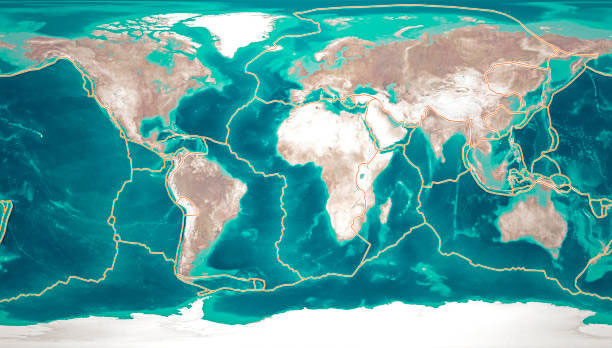The Earth’s crust consists of many plates that are constantly moving, cracking, and sliding over one another. The forces from the deep, molten core seem insufficient to explain this phenomenon. American scientists have discovered a new cause from the cosmos.
According to research recently published in GSA Special Paper, the mutual gravitational interactions between the Sun, Earth, and its sole Moon are the primary reasons behind the movement of tectonic plates – which are essentially the pieces of the Earth’s crust.

The Earth’s surface is made up of many different crustal pieces, which are tectonic plates – (Illustration from iStock)
As previous studies have shown, the Earth’s crust is not a continuous layer but consists of approximately 15-20 large and small pieces that are in constant motion, cracking apart, drifting away from each other, colliding, and subducting beneath one another. The movement of these plates leads to the shifting of continents and oceans, causing the Earth’s landmasses to repeatedly come together into supercontinents and then break apart into separate continents.
The cause of plate tectonics has remained a hypothesis supported relatively by indirect evidence, with the widely accepted theory being that it is due to convection currents within the Earth’s core. However, the research team led by geophysicist Anne Hofmeister argues that this explanation is insufficient.
Science Alert cites their analysis of “cosmic impacts”: the actual center of the Earth shifts by up to 600 km during the month because the Moon’s orbit around the Earth is elliptical, not circular. This means that the Earth is continuously compressed and stretched due to gravitational interactions with the Moon.
Moreover, the pressure increases as the Earth rotates on its axis and is slightly flattened rather than being a perfect sphere. It also orbits the Sun in a “wobbly orbit” while spinning on its own axis. Thus, the planet inadvertently undergoes a series of complex deformations.
“The warm, thick, and ductile inner layers of the planet can withstand this pressure, but the thin, cold, and brittle lithosphere responds by fracturing,” the authors explain.
Additionally, the gravitational interactions combine with the forces of deep currents in the outer core, causing the plates to continuously shift.
While this may sound alarming, the very tectonic activities that result from these impacts have contributed to our existence: plate tectonics is crucial for balancing the carbon cycle and many other cyclical processes on the planet, maintaining a stable climate, facilitating the necessary reactions for life to emerge, preserving that life, and promoting evolution.
















































